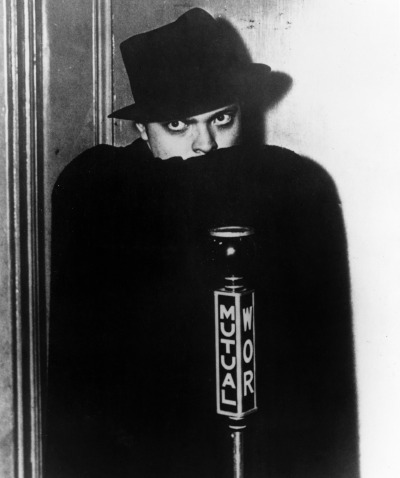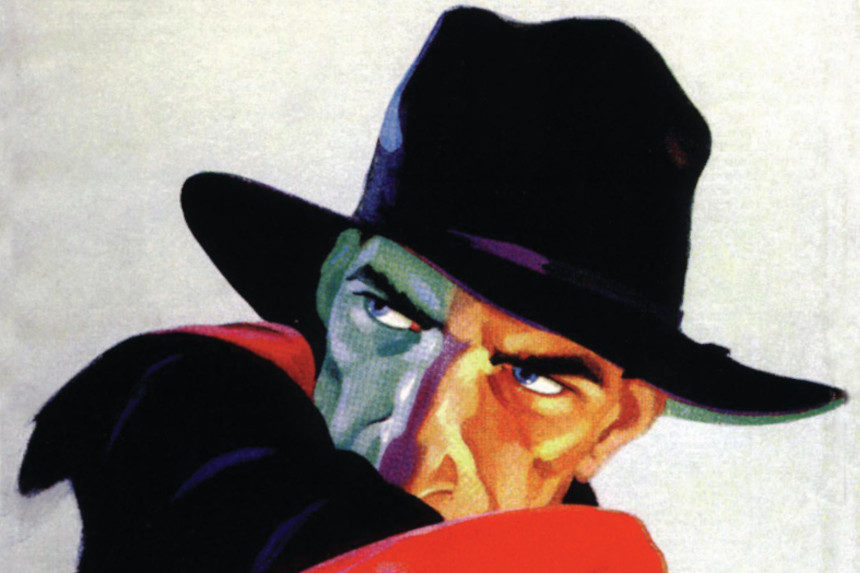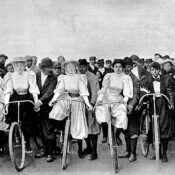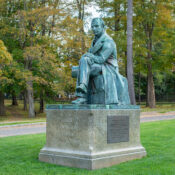In July, writer James Patterson will start releasing new novels featuring The Shadow, aiming to reintroduce the famed 1930s pulp magazine and radio crime fighter to a new generation of fans.
The mysterious figure, with his iconic trench coat, dark fedora, flowing red scarf, and piercing bitter laugh, will be entering a superhero-dominated entertainment world he himself helped create. During the tail end of the Great Depression and the early days of World War II, The Shadow gained a nationwide following as a fighter of evildoers and criminals.
Batman’s creators cited him as a direct inspiration. His ability to hypnotize victims and appear invisible —which wasn’t part of the character’s original design, but developed over the years — was an early example of how special powers could enhance a multimedia hero’s popularity. What The Shadow’s creators discovered — quite by accident — is that making a hero who is darker and scarier than the bad guys he fights would strike a deep chord in American culture. During one of the most tumultuous periods in American history, what many wanted was not a hero to light the way but a monster of their own.
“The Shadow, more than any other character, is the foundation for the comic book industry as we know it today, for superheroes,” said Michael Uslan, a comics historian and professor at Indiana University, and also a producer for several Batman films. “It was a dark time, it was darkness everywhere you turned. And you needed a vengeful form of darkness out there to counter it.”
“The Shadow, more than any other character, is the foundation for the comic book industry as we know it today.”
The Shadow’s development involved equal parts inspiration and happenstance. In fact, he began not as a character but as a marketing gimmick. In 1930, Street & Smith, the nation’s largest publisher of pulp magazines, decided to use a radio show to bolster sales of Detective Story Magazine, one of its oldest publications. They created an anthology show with a series of distinct mysteries, similar to what was in the magazine. But they needed a narrator to provide the show’s “voice of conscience,” according to The Shadow: The Making of a Legend by radio and pulp historian Anthony Tollin. It was a 25-year-old radio scriptwriter, Harry Engman Charlot, who suggested the name.
When the show premiered on July 31, 1930, actor James La Curto first intoned the phrase that would become implanted in the public’s memory — “The Shadow knows.” The voice was so entrancing that newsstands reported to Street & Smith that readers were asking for The Shadow books, even though there weren’t any. The publisher realized it had to start printing some soon or it could lose out on the popularity (and the trademark).
Street & Smith turned to 33-year-old Philadelphia journalist Walter Gibson to meet the demand. With only the name, voice, and sinister ambience to start with, he used the assignment as a chance to fulfill a longtime goal of creating a hero as captivating as a villain.
“Why, in all the modern movies, stories[, and] novels, does the villain get away with all sorts of wild stuff, and the hero act like a hick?” he wrote in a 1918 diary entry, according to biographer Thomas Shimeld’s Walter B. Gibson and The Shadow.
“I needed an outstanding character, and I had been thinking of one who would be a mystery in himself, moving into affairs of lesser folk much to their amazement,” Gibson recalled to Tollin years later.
A former magician’s assistant who worked with Harry Houdini and harbored a lifelong fascination with stagecraft and theatrics, Gibson crafted a character who seemed able to conjure himself down every alley and behind every flophouse door, yet could elude criminals as deftly as a whisper. The Shadow used tricks that kept readers guessing about the exact nature of his powers — and whether or not they included the supernatural. Unlike his more scrupulous protégés of the superhero era, The Shadow had no qualms with shooting or killing, using his iconic dual pistols to gun down crooks in self-defense or to save others.
While The Shadow commanded a strong following through the pulps, by returning to radio in 1937 he became a nationwide phenomenon. Until then, the radio character had been just a narrator of the anthology show, but Street & Smith decided it was time to give the character a starring role. Producer Clark Andrews and script editor Edith Meiser came up with a formula for radio, broadening the character for a general audience. Gone were the pistols, as well as the bloodlust.
The show was a hit. Meiser, a suffragist and former vaudevillian as well as a mystery buff, focused on The Shadow’s detective role. She and the other writers condensed The Shadow’s portfolio of identities into a single person — Lamont Cranston, a dilettante and playboy by day who became a vigilante at night. (In the novels, Cranston was but one of The Shadow’s many identities.) And The Shadow’s network of spies was tossed for a single sidekick, the vaguely romantic companion Margo Lane, whose feminine voice and repartee with Lamont helped ground and balance the broadcast.
Most Shadow historians believe Meiser was instrumental in drawing up the Lane character, and after Meiser’s departure in 1938, Lane would devolve from a driven partner to a more typical damsel-in-distress role. Lane was first played by Agnes Moorehead, the famous actress who would go on to delight audiences on Bewitched.
Gibson had little involvement in the radio show, but he may have provided one of its most important attributes. At least according to his own recollection, he and writer Edward Hale Bierstadt concocted The Shadow’s invisibility to solve a plot conundrum while working on the script for the show’s premiere episode. It was the only episode Gibson was involved in.
Gibson crafted a character who seemed able to conjure himself down every alley and behind every flophouse door, yet could elude criminals as deftly as
a whisper.
While the novel’s character surprises criminals through a variety of tricks and ruses, radio’s version shortcut this with an ability to “cloud men’s minds” and become unseen, through vague and never-explained hypnotic abilities developed during world travels. To his foes, The Shadow became what he was to the listener as well — only a clear, haunting voice. His invisibility worked not only as a practical way to skip plot exposition but also to place listeners immediately in the action. “How could there be a more perfect radio character than an invisible man as ethereal and unseen as the radio waves themselves?” wrote Tollin.
And by an extraordinary stroke of cosmic luck, the show found one of the most famous voices in the history of American show business to fill that role — 22-year-old Orson Welles. Already well known from his theater work, but not yet a household name, he was perfect for the role — a young, strong talent who wouldn’t upstage the mystery. Even at this early age, Welles could muster the silky, authoritative voice that would become iconic in film and television for decades to come.
Many Shadow fans don’t view Welles as the best Shadow of the five actors who played him, but he is certainly the most well known. Welles’ own shadow falls heavily over the character’s history, even though he was only barely involved in it. (And he could never get the laugh right — his predecessor, Frank Readick, provided the famous opening lines and cackle.)
Juggling the show with several other creative projects where he focused his energy, Welles refused to attend rehearsals and often showed up late to the live performances. He would arrive to the station — in an ambulance he commandeered to rush through New York traffic — just in time to read his first lines, according to Young Orson, a biography by Patrick McGilligan. Sometimes Welles didn’t even have time to read the script in advance. “Once we got to the middle break, and he turned to me and said, ‘Hey, this is a hell of a script, how does it end?’” series writer Sidney Slon told Tollin.
Welles lasted only one season, as his fame following the 1938 War of the Worlds broadcast upstaged the show, robbing The Shadow of his mystery. But the series persisted as one of the most popular in the country for years. In 1938, it became the top program for daytime radio, according to The Shadow: The History and Mystery of the Radio Program, 1930-1954 by Martin Grams.
At around the same time, comics writers Bob Kane and Bill Finger were desperately trying to conceive a superhero who could replicate the success of Superman, who had made his debut in June 1938. Both were voracious pulp readers and admitted they drew inspiration from The Shadow while developing their own famous creation, Batman. Fans of the two characters have noted that the first 1939 Batman story, “The Case of the Chemical Syndicate,” follows nearly beat-by-beat a 1936 Shadow novel, Partners in Peril. Such copying was not uncommon in the fast-paced, cutthroat world of comics, as underpaid writers scrambled to keep up with relentless demand.
Even beyond the near-plagiarism, The Shadow and Batman clearly share a kindred spirit — fearsome personas, a hatred of crime and evildoers, populist missions combined with aristocratic backgrounds, and hidden pasts of trauma and pain, as well as a tendency to blur the line between hero and villain.
“To me, the appeal of The Shadow is that he’s very simple and he’s very primal,” said Steve Orlando, who wrote and co-wrote a series of Batman and The Shadow crossover comics from 2017 to 2018. “I think he is an imperfect thesis statement that the character of Batman perfects.”
But while Batman’s noble purpose may make him more palatable, The Shadow’s thirst for vengeance evokes feelings that can cut deeper. “He’s a person who scares the folks that scare us,” Orlando said. “It’s brutalistic and it’s petty, and it’s a little unattractive. But it’s also real and it’s human.”
The Shadow came about during an era of seemingly neverending joblessness and crushed opportunity, as well as corruption and the apparent lawlessness of Prohibition-era gangsters and brazen bank robbers. “There’s a reason that a majority of the villains were racketeers, corrupt politicians, evil rich wealthy men of corporate society who were more interested in profits than they were in the common man,” Uslan said. “And these stories were about somebody who would be there to defend and protect and fight for the common man.”
While Superman or Captain America may be who you hope for when you look at the stars, Batman or The Shadow is the one who’d have your back on the streets. “When you’re in the darkest part of town, and you know no Boy Scout is going to come to save you, you hope one of the rough figures in the darkness can stick up for you,” said Travis Langley, a psychologist and author of Batman and Psychology: A Dark and Stormy Knight.
Unlike Batman and Superman, however, The Shadow struggled in visual media. Black-and-white serial features, comic books, and strips didn’t make as strong a public impression as the pulps and radio shows. Television pilots were never picked up. The Shadow only seemed to work in theaters of imagination, where he could achieve a larger-than-life presence in the minds of captivated fans.
The Shadow signed off from radio in 1954, and Street & Smith folded and was bought by Condé Nast in 1959. While still carved into the memory of a generation that spent its childhood in front of a radio set, the character seemed destined to lie dormant.
But syndication of the radio episodes and reprints of the novels sparked a renaissance among pulp enthusiasts in the ’60s and ’70s. DC Comics published new comic books for The Shadow in 1973, hoping to introduce the character to a wider spectrum of fans. By then, comics had developed a surreal, noirish style that could better suit The Shadow’s atmosphere, and issues by Dennis O’Neil and Howard Chaykin were well-received by fans.

Critics were less generous to a 1994 movie starring Alec Baldwin, made in the wake of the 1989 smash hit Batman. With a middling box office, the franchise fizzled, and Shadow fans remain divided about the film.
More recent novels and comics have pulled elements from different Shadow stories, often creating a character who combines the pulp version’s raw vengeance with the radio’s hypnotic abilities. Writers debate whether The Shadow works better in a Depression-era setting, or if he is a timeless hero like Batman or Superman and can save citizens from our present-day troubles.
James Patterson — who admitted The Shadow’s radio voice gave him some nightmares as a kid — said he will include noir and sci-fi in his new Shadow books, which will see the character in his traditional 1930s setting but also mysteriously transported to dates in the future. “It’s an interesting character who I just thought could be appropriate right now, but not in the way he was in the ’30s,” he said.
There was no particular stroke of genius in The Shadow’s creation, no writer or artist with a grand vision. He was cobbled together through happenstance and accident by talented but overworked writers, editors, and producers all desperately probing the public’s appetites. They discovered a disquieting truth, that we sometimes would rather have a monster by our sides than a hero.
But The Shadow, of course, always knew.
Alex M. Parker is a journalist based in Washington, D.C., who often writes about pop culture. Our regular contributor to American Pop, Cable Neuhaus, will return for our next issue.
This article is featured in the July/August 2021 issue of The Saturday Evening Post. Subscribe to the magazine for more art, inspiring stories, fiction, humor, and features from our archives.
Featured image: Retro AdArchives / Alamy Stock Photo
Become a Saturday Evening Post member and enjoy unlimited access. Subscribe now




Comments
If you can find it, there is a 1970s Batman comic book where Batman has an encounter with the Shadow in the present-day. It turns out that young Bruce Wayne was on scene decades earlier when the Shadow thwarted jewel thieves and saved young Bruce’s life! In the present-day, Batman gets to say to the Shadow “I’ve never told anyone, but you were my greatest inspiration.” As I recall, the story got a tremendous response from readers who loved it. DC published a noir period-set Shadow comic and the adult Lamont Cranston turned up in another comic series, hinting at more adventures. But DC lost the rights to the character and it was not to be! (Oh, and I loved the 90s movie!)
My mother said I was too young to listen to that first radio performance of The Shadow in 1930. I was a month old but already quite impressionable. Years later I attended a Shadow broadcast and saw that Lamont slipped into a booth when he assumed the Shadow’s character and deeper voice. It was kind of a letdown. I was hoping he’d actually disappear on the stage.
While mildly interesting, it’s clear that journalist Alex M. Parker was in a rush and didn’t do much reading and research. His opening lines about The Shadow and Patterson’s new novel show that he hasn’t even read reviews or summaries, no less the novel itself. Parker relegates Walter Gibson to the status of “a former magician’s assistant” and the article’s author really exhibits his ignorance of his subject when he writes that: “There was no particular stroke of genius in The Shadow’s creation, no writer or artist with a grand vision. He was cobbled together through happenstance and accident by talented but overworked writers, editors, and producers all desperately probing the public’s appetites.” Parker writes as if The Shadow was static, with no movement or development in the 18 years that he appeared in “The Shadow Magazine” Walter Gibson was much better at delivering quality writing by deadlines than Parker is here.